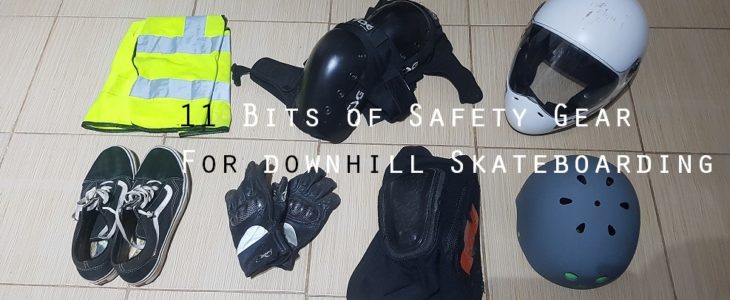When you start longboarding, sorting out your safety gear should be a top priority.
This weeks article is a simple guide that covers the basics of what you need and what you may not necessarily need. Check it out below!
NB: This article is targeted towards beginners and what gear is essential for them. If you’re a more advanced rider I’m sure you have your own opinions about what works well. You can comment below and we can discuss. Any input is always welcomed.
This article is part 3 of a 5 article series on skateboarding protection. Check out the other articles here:
- 9 best helmets for longboarding/skating and the ones to avoid
- TSG DHP Knee Pads Review
- Understanding Downhill Skateboarding Helmets
- TSG Pass Helmet Review
11 types of protective gear for downhill skating
Is a Helmet necessary?
What do they do and what you should look out for
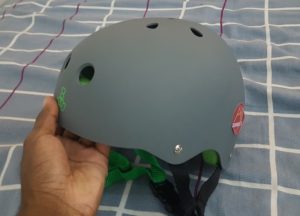 Helmets protect your head from any impacts. They typically use EPS foam that expands on impact and absorbs any force that would usually concuss you. An impact force of over 300Gs can give you a traumatic injury so helmets try to reduce the impact force to below that value.
Helmets protect your head from any impacts. They typically use EPS foam that expands on impact and absorbs any force that would usually concuss you. An impact force of over 300Gs can give you a traumatic injury so helmets try to reduce the impact force to below that value.
So in order to ensure that a helmet can actually do this, safety institutes have provided ratings (i.e qualifications) for helmets. These qualifications basically tell you that a helmet will work the moment it’s most needed to.
In summary, you should only buy helmets rated by relevant safety associations. This is because the safety ratings guarantee that the helmet will protect your head when you need them to. Helmets without safety ratings don’t guarantee protection and they should simply be avoided.
You can typically find the ratings on the inside of the helmet. The image below shows what you’d typically find in a half-shell helmet.
Half-shell helmets safety ratings 
- U.S. CPSC Bike or,
- ASTM F-1492 rating or,
- European CE rating
Full-face helmet safety ratings
- EN 1078 or,
- ASTM1952
Are they necessary?
Yes. Absolutely. I would argue that they are mandatory for all beginners. Traumatic head injuries can happen and they can really put a damper on your skate career.
However, they become less ‘necessary’ for just cruising around the more experienced you get. You 100% need them if you are bombing hills regardless of skill level. But when just cruising around, an experienced rider would be ok without one. This is because you have all the muscle memory from learning and falling over when you were starting out. You can recognize when you are gonna bail (one of the few times you will do so from simply cruising) and you can abort early enough to avoid anything bad.
But of course, take it with a pinch of salt. Accidents are … accidents. They happen when we least expect them to. It’s up to you (as an experienced rider) to decide if a helmet is mandatory for simply cruising.
So helmets, the half-shell or the full-face?
I’d say when you start out, half-shell helmets are the way to go. This is because you will most likely be sessioning small corners and skating up and down small hills – rather than tackling huge mountain passes.
Check out the Triple 8 Dual Certified Helmet here on Amazon.com to see an example of what a half-shell helmet is.
Or checkout the high-rated S1 lifer here at Stoked Ride shop.
The half-shell will keep you cool whilst still providing adequate protection (under speeds of 30mph). Whilst the full-face will provide better protection, it will simply be overkill for speeds under 30mph = and when you are starting out.
Check out the TSG Pass here on Amazon.com for an example of a great full-face helmet.
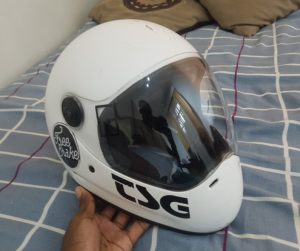 It’s tempting to buy one so you can look and feel like all the great riders you see in videos, but it simply isn’t practical. When you are hiking up hills and practicing slides, full-faces are cumbersome, uncomfortable to use. get hot quickly, and are really heavy to carry around.
It’s tempting to buy one so you can look and feel like all the great riders you see in videos, but it simply isn’t practical. When you are hiking up hills and practicing slides, full-faces are cumbersome, uncomfortable to use. get hot quickly, and are really heavy to carry around.
As an owner of both, I choose my half-shell over my full-face every time for local riding and corner sessions. But my full-face is my number one choice when riding over 40mph.
Also to note, full-faces are really great in winter. They keep your face warm and safe from the bitey and chilly wind. But ultimately, half-shells are my recommendation for beginners.
Hip-pads, what are they and are they useful?
You will fall on your hip more often than you will expect, especially as and when you are learning to slide. Because of this, I think hip-pads should be part of the basic kit a beginner downhill skateboarder uses.
What do they do?
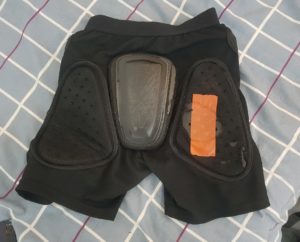 The function of the hip-pad is all in the name. They simply protect your hips and waist area when you fall over. I argue that they are an underrated part of downhill skateboard protection.
The function of the hip-pad is all in the name. They simply protect your hips and waist area when you fall over. I argue that they are an underrated part of downhill skateboard protection.
People look at our sport and think that knee pads, elbow pads are most essential, but what they don’t realize is that you don’t fall over ‘perfectly’ every time. Most of the times, falls are very awkward and catch you off-guard – you may end up falling on your knee pads one time and then your hips the other, and then your back … etc. So elbow and knee pads are really just one piece of the puzzle.
A good example of a hip-pad is the G form. You can also find the Gfrom hip pads here at Stoked Ride shop.
You can also find the hip pads here on Amazon.com.
Are they necessary?
I would argue yes. Whilst you can sort of get away with not having one for yourself, you’d be alot better off with one. You can’t really avoid falling on your hip, especially when you start out.
Hip pads will prevent a lot of unnecessary hip injuries and bruises. They will allow you to get up and continue your session after a gnarly hip-fall – When such a fall will ordinarily leave you sidelined.
Which ones should you go for?
The g-form options are great for smaller riders. They use their revolutionary ‘RAPT’ technology which allows the pads to stay thin whilst still being able to absorb large impact forces. However, the heavier you are, the less effective these become. If you are heavier 140lbs/65kg, you should get the Hillbilly pads below.
The Hillbilly Impact Shorts are a bit thicker and better for heavy set riders. Unlike the G-form, these feature EVA foam and plastic ‘cup’ on the tail of the shorts. The plastic tailbone is nice because it accommodates the fact that you will be sliding on your ass a lot. The plastic material should hold up well against this.
Check out the Hillbilly Impact Shorts here on Amazon.com.
Strong pants
You will go through more pairs of pants than you will expect. I ate through 5 in the first few months of my skating alone – I’ve lost track of my body count since.
A good strong (or cheap set) will work best. It’s usually easiest to get some from your local charity shop.
Another option is to get jeans. Jeans have great abrasion resistance and tend to last longer than your basic set of chinos/pants. However, they tend to be inflexible, which is their main drawback. But still, they remain to be my go-to option. If I can get an affordable set that feels flexible, I always hit the send button and purchase them.
The last option is to sew-in leather on the bum section of your pants. Leather has great abrasion resistance and will really increase the life/durability of your pants. However, it is a bit of extra work – that might pay off over the months, with one single set of pants lasting you where you would have bought a handful.
I think it’s wrong to not include shorts on this list. Shorts are especially nice in really warm climates but should always be paired with a good set of knee pads to keep your exposed knees protected.
Knee pads – Do you knee’d em?
What do they do?
Knee pads are another item beginners should absolutely buy. Their job is to simply protect your knees when you fall over.
Check out the TSG Sk8 DHP pads here on Amazon for a good example of a knee pad.
Are they necessary?
Yes. Absolutely. You will fall more times on your knees than you will be able to count. It’s important you have knee pads, so you can safely fall without and get back up without injury.
Hard or soft-shell knee pads?
Softshell pads are made from a flexible material. They are usually very breathable, absorb impact well and very non-intrusive.
Hardshell pads usually have a plastic ‘cover’ that takes the brunt of an impact and prevents any abrasion from occurring.
Depending on the option you choose and your situation, either can work well for you.
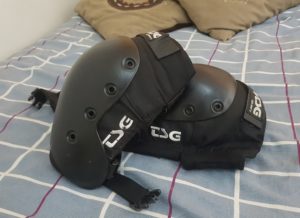 Softshell pads are great if you want something extremely low profile that you can wear under your clothes. However, whilst they will absorb impact force they won’t provide abrasion resistance. Meaning, they will tear if they slide against the asphalt for too long.
Softshell pads are great if you want something extremely low profile that you can wear under your clothes. However, whilst they will absorb impact force they won’t provide abrasion resistance. Meaning, they will tear if they slide against the asphalt for too long.
Hardshell pads are great if you want excellent abrasion resistance. However, they do tend to be bulky and can get in the way of your skating – if you choose the wrong ones. However, they remain my go-to pick for what I think most riders – especially beginners, should go for.
In summary, softshell pads are better for riders who can pick themselves from the asphalt when they fall – and go on their toes as they slow down. Hardshell are better for beginners who are still a bit awkward in their movements and knee’d the protection.
What are some good knee pad options?
A good softshell option is the D3O. Like the Gform shorts above, these use proprietary technology to keep the pads thin whilst still providing excellent impact absorption. But unlike the Gform, the D3O provides great protection for heavier riders too. Check out the D3O mountain boarding knee pad here on Amazon.
Gform pads also protect decently but are better for lighter riders. They don’t provide much protection if you’re over 120lbs … Check out their selection here at Stoked Ride shop.
A great hardshell option is the TSG Sk8 DHP. These have been purpose-built for downhill skateboarding from the ground up. They would theoretically last you a few years, whilst the other pads would struggle to last for a few months. Because they have been designed for downhill skating, they feel non-intrusive and don’t get in the way of your skating – so there really isn’t any excuse to not choose them .. apart from the cost. You can read my review of the knee pads here.
Slide gloves – absolutely necessary
Slide gloves are a must if you plan on bombing hills. They provide your hands with protection if you fall over and give you a means of slowing down – apart from foot braking, this is what downhill skaters use to produce the smooth controlled powerslides that bring them to a halt.
What are slide gloves and how do they work?
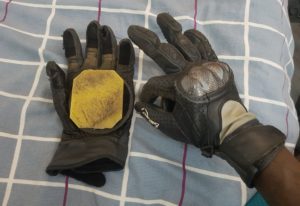 They typically utilize a puck placed on the palm of a glove. The puck is typically made from a slidey, abrasion-resistant material.
They typically utilize a puck placed on the palm of a glove. The puck is typically made from a slidey, abrasion-resistant material.
The first slide gloves made were simply gardening gloves with pieces of kitchen cutting boards hot-glued onto them. They worked, but they didn’t provide the smoothest glide or sliding experience.
Thankfully, technology has progressed quite a bit these days and slides gloves are great and comfortable to use.
What are some great slide pads?
The Loaded leather race gloves are an excellent choice for beginners. They come with fingers pucks and are made from durable wear-resistant materials. Read my review of these gloves here. I personally use these gloves and I think they are some of the best on the market – given their all-round use and appeal.
You can buy the Loaded gloves here on Amazon.com.
Spine protectors
What are they and how do they work?
It’s all in the name. Spine protectors protect your back and spine from any impact and scrapes.
They are usually very flexible, with cutouts that allow them to move naturally with your back as you bend and move your body around.
Finally, they are usually made from a variety of materials. A hard plastic usually features, paired with an impact-absorbing foam like EVA, Kevlar or D3O.
Are they really necessary?
Starting out spine protectors are really overkill. You aren’t going fast enough, nor are skating ‘dangerous’ enough roads as of yet. Spine protectors make sense as you get to those higher speeds on open roads and at skate events.
Given we tend to go really, really fast (think 40-70mph), as we got more experienced. A mistake could have you wrapped around a guard rail, your spine taken out by a tree, or leave us under the tire of an oncoming vehicle.
Spine protectors become absolutely necessary as you get to those faster speeds and riskier situations. A simple error of calculation could leave you in risk of a permanently damaged spine. You need them to keep you safe as you skate and push your limits.
Check out the Dainese Manis here on Amazon, for an example of a high-quality back protector.
In summary, as you start out spine protectors really aren’t necessary for beginners. However, as you get more experienced and start tackling more challenging runs, they should be a serious consideration for your arsenal of protective gear.
Elbow pads
What do elbow pads do?
They protect your elbows when you fall over. Elbows are typically vulnerable because, after your hands, they are usually the first part of your upper body that makes contact with the ground when you fall over.
Are they necessary?
Elbow pads are an item most would say aren’t super necessary. You already have the slide glove protecting your hands, and you can catch yourself with them if you fall over. But that said, they would be nice for beginners.
When you start out, you are still a bit awkward and haven’t got the habit of going on your hands when you fall over. Elbow pads may make the transition a tiny bit easier.
Which elbow pads are best?
So personally, I wouldn’t pick the hardshell options. I say this because you usually go on your slide gloves as soon as you realize you’re falling over. In a way, the elbow pads will only be taking the brunt of the impact before you transition to sliding on your palms.
I think the softshell options would work really good here.
For example, the D3O mountainboard pads would be a good option. You can pick up a set on here Amazon.com.
Ankle protectors/Hi-top shoes
What do they do?
Ankle protectors protect your ankles. They keep them from getting injured when you fall over awkwardly.
Are they necessary?
These may seem out of place here, but are an absolute option for most skaters. Especially if you use shoes that rest low on your ankles (think Converse low-tops).
Admittedly, I’ve gotten a fair few nicks and bangs on my ankles, especially when I was learning. If I had some really basic ankle protectors, I would have been able to save myself a lot of skin (and socks too).
You can buy a set of ankle protectors like these (links out to Amazon.com), or simply get some hi-top shoes. Hi-top shoes are better as you have fewer moving parts. But each to his own. Find what works best for you and stick to it.
In summary, I think ankle protectors (or simply hi-top shoes) would have gone a long way and saved me some skin. Beginners should consider getting their own pair.
Leather suits?
What are they?
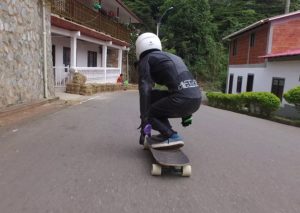 Leather suits are simply flexible leather “one-sies”. They have been designed from downhill skating from the ground up.
Leather suits are simply flexible leather “one-sies”. They have been designed from downhill skating from the ground up.
Because leather has excellent abrasion resistance, these are great for protection when skating fast and when racing at a high-level. They are non-intrusive and don’t get in the way of your skating.
Unlike motorcycle suits, these are much thinner and are more flexible at the necessary points along your body.
Should you get a suit?
Starting out, longboard leathers are really non-essential pieces of kit. They are also quite costly if you get them made – but they are a bit more affordable if you get them second-hand or choose a really generic version.
Whilst they do provide excellent protection, they are a bit of overkill in my personal opinion. However, a lot of beginners I know regularly use them and enjoy doing so!
A lot of those riders are a bit older. They don’t seem to mind the cumbersome-ness of having to lug leathers back to the top of the hill. I think perhaps its wisdom or something …
But it makes sense, you want to commit to doing a sport without much/wanting to worry too much about the injuries, scrapes, and road rash you might get along the way.
So I guess this one is really about personal preference …
But ultimately, yes. Somewhere down the line it does make sense to get a good set of custom leathers.
Sunglasses/Glasses/Eyeshields
What they do:
Protect your eyes from UV and harsh sunlight. They also prevent unwanted things from entering your eyes – think dust and bugs.
Are they necessary?
Believe it or not, these things are kinda important. They keep your eyes clear and free from dust and bugs as you go down the hill. They also keep your eyes from tearing up from all the wind.
 They act in a similar way to a visor, but only really protect your eyes. This is nice as it still leaves air to go around your face, ultimately cooling you down.
They act in a similar way to a visor, but only really protect your eyes. This is nice as it still leaves air to go around your face, ultimately cooling you down.
They go well with a half-shell (and full-face if it has enough space to accommodate them).
I think they are necessary as there is nothing worse than getting your eye taken out by dust or a bug. It can lead to a sketchy situation – like having to take a corner half-blind at 40mph. I think we can all agree that is a less than ideal situation.
So yeah, get some sunglasses/eye-shields and protect your eyes.
Gripsoles/Brakesoles
What are gripsoles and what do they do?
 Grip soles, in a nutshell, are just slick pieces of rubber glued to the bottom of your shoe. They allow you to footbrake without destroying the actual sole of your shoe. They also add more ‘grip’ to your board – think of how a smooth rubbery compound grips against a coarse surface. Essentially ‘sticking’ you to your board a whole lot more.
Grip soles, in a nutshell, are just slick pieces of rubber glued to the bottom of your shoe. They allow you to footbrake without destroying the actual sole of your shoe. They also add more ‘grip’ to your board – think of how a smooth rubbery compound grips against a coarse surface. Essentially ‘sticking’ you to your board a whole lot more.
But grip soles do more than just add grip you more to your board. They essentially allow your shoes to last a lot longer – which I think should be the key selling point for a majority of us.
Are they necessary?
When you start out, your primary method of slowing down will be foot braking. Now for most shoes, footbreaking will literally eat the soles and cause them to wear out within a few weeks of using them.
Grip soles are the solution to making your shoes last longer. However, given that the current market options can be a bit expensive (and overly grippy for most beginners). I think you should go for my ‘hack’ option – which I explain in depth below.
How can you make your own grip sole?
If you can afford to buy shoes every few months, then these aren’t for you. Same if you can afford to buy the after-makert gripsoles.
However, if you like your shoes and want them to last you a long time – but need a cheap option, then the foot brake soles below are the option for you.
Now, my ‘hack’ option makes use of rubber that isn’t too grippy on your board. The idea here is to simply make your shoes last longer.
- Go into a store and buy the smoothest, least bumpy rubber car matt you can find, along with Loctite (or any) superglue.
- Cut out a slightly larger outline of your sole from the rubber.
- Run your blade across the sole in various directions, to rough it up in order for the glue to stick easier.
- Stick the rubber using the supper glue to your sole. Make sure you give it time (and pressure) to stick.
- Finally trim it to fit the outline of your sole. And voila, you now have a rubbersole.
- Touch them up with the superglue any time a part of the sole unsticks.
The idea here is to simply have a cheap material you can wear out and easily replace continuously. This is so you can make the most out of your shoes and ultimately reduce the cost of your skate experience. Rubber car matts are perfect for this and a one matt can last you a couple of months.
What gear should you get as minimum? A conclusion
A lot of the gear suggested here is because of my years of experience as a downhill skater. Starting out, I definitely thought a lot of the above things weren’t necessary – but experience soon taught me otherwise. A lot of the time though, I couldn’t afford the safety gear outright, even if I did realize their importance and why I should use them.
If I had to choose for you, I would suggest getting a helmet, a pair of knee pads and slide gloves as the bare minimum. Your next purchase should then be a set of hip pads and this should basically keep you comfortable for a long time to come.
But ultimately, it’s up to you, what you think and what your wallet can afford. But something good to know, is that you can always buy the equipment in bits and slowly fill up your list of gear. If you’re buying someone safety gear as a present, check out my list of the best presents for skateboarders to help you out.
